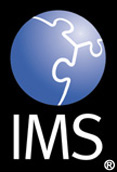 |
1EdTech ePortfolio Information Model Version 1.0 Final Specification |
Copyright © 2005 1EdTech Consortium, Inc. All Rights Reserved.
The 1EdTech Logo is a registered trademark of 1EdTech/GLC
Document Name: 1EdTech ePortfolio Information Model
Revision: 02 June 2005
IPR and Distribution Notices
Recipients of this document are requested to submit, with their comments, notification of any relevant patent claims or other intellectual property rights of which they may be aware that might be infringed by any implementation of the specification set forth in this document, and to provide supporting documentation.
1EdTech takes no position regarding the validity or scope of any intellectual property or other rights that might be claimed to pertain to the implementation or use of the technology described in this document or the extent to which any license under such rights might or might not be available; neither does it represent that it has made any effort to identify any such rights. Information on 1EdTech's procedures with respect to rights in 1EdTech specifications can be found at the 1EdTech Intellectual Property Rights web page: http://www.imsglobal.org/ipr/imsipr_policyFinal.pdf.
Copyright © 2005 1EdTech Consortium. All Rights Reserved.
Permission is granted to all parties to use excerpts from this document as needed in producing requests for proposals.
Use of this specification to develop products or services is governed by the license with 1EdTech found on the 1EdTech website: http://www.imsglobal.org/license.html.
The limited permissions granted above are perpetual and will not be revoked by 1EdTech or its successors or assigns.
THIS SPECIFICATION IS BEING OFFERED WITHOUT ANY WARRANTY WHATSOEVER, AND IN PARTICULAR, ANY WARRANTY OF NONINFRINGEMENT IS EXPRESSLY DISCLAIMED. ANY USE OF THIS SPECIFICATION SHALL BE MADE ENTIRELY AT THE IMPLEMENTER'S OWN RISK, AND NEITHER THE CONSORTIUM, NOR ANY OF ITS MEMBERS OR SUBMITTERS, SHALL HAVE ANY LIABILITY WHATSOEVER TO ANY IMPLEMENTER OR THIRD PARTY FOR ANY DAMAGES OF ANY NATURE WHATSOEVER, DIRECTLY OR INDIRECTLY, ARISING FROM THE USE OF THIS SPECIFICATION.
Please note that the British Standards Institute standard 8788, provisionally known as "UK Lifelong Learner Information Profile" and referred to in this specification, is under development by the BSI. For further information, please consult http://www.bsi-global.com/.
Table of Contents
1. Introduction
1.1 Structure of this Document
1.2 Nomenclature
1.3 References
2. ePortfolio Overview
2.1 Rationale
2.2 Business Requirements
2.2.1 Parts to be Included and Excluded from the Scope of ePortfolio
2.3 Out of Scope
2.3.1 ePortfolio Services
2.3.2 Storage of ePortfolio Information
2.4 Intended Users
2.5 Related Specifications
3. Portfolio Packages
4. Data Model
4.1 Portfolio Class
4.1.1 Owner Class (Abstract)
4.1.2 Presentation Class
4.1.3 View Class (Abstract)
4.2 PortfolioPart Class (Abstract)
4.2.1 Accessibility Class
4.2.2 Activity Class
4.2.3 Affiliation Class
4.2.4 Assertion Class
4.2.5 Competency Class
4.2.6 Goal Class
4.2.7 Identification Class
4.2.8 Interest Class
4.2.9 Other
4.2.10 Participation Class
4.2.11 Product Class
4.2.12 QCL Class (Qualification Class)
4.2.13 Reflexion Class
4.2.14 Relationship Class
4.2.15 Rubric Class
4.2.16 RubricCell Class
4.2.17 SecurityKey Class
4.2.18 Transcript Class
4.3 Assertion Class Description
4.3.1 Description
4.3.2 Attributes
4.4 Reflexion Class Description
4.4.1 Description
4.4.2 Attributes
5. Extending the Information Model
5.1 Proprietary Extensions
About This Document
List of Contributors
Revision History
Index
1. Introduction
This document is the 1EdTech ePortfolio Information Model v1.0 and as such it is used as the basis for the development of the 1EdTech ePortfolio Binding v1.0 [EP, 05b]. There are many possible bindings of the Information Model but at the current time the only specified binding is to XML using existing specifications.
Because many of the data types used to define an ePortfolio are described in existing specifications and standards, this information model does not replicate these definitions. Instead, readers should refer to the XML Binding document to see how the concepts described in the information model should be realized.
1.1 Structure of this Document
The structure of this document is:
1.2 Nomenclature
| CSS | Cascading Style Sheets |
| W3C | World Wide Web Consortium |
| XML | Extensible Mark-up Language |
| XSD | XML Schema Definition |
| XSL | Extensible Stylesheet Language |
| XSLT | XSL Transformations |
1.3 References
2. ePortfolio Overview
2.1 Rationale
The use of ePortfolios in distributed learning in compulsory and higher education worldwide has increased dramatically over the last five years. While ePortfolios previously took the form of static Web pages, the growth over the last few years has been fueled by the growing availability of commercial and open source ePortfolio tools in the form of database-driven, Web applications. Currently available systems, known to the 1EdTech ePortfolios Development Committee, store ePortfolios in formats that do not reflect accepted open standards, and have no facilities for importing and exporting ePortfolio information conformant with accepted standards. This makes it difficult or impossible to move ePortfolios intact between systems, and leads to inefficiency and redundancy when integrating ePortfolio tools with other enterprise systems.
In addition to being used in particular courses, ePortfolios are increasingly being used across whole programs and institutions. ePortfolios are beginning to be used as tools for personal development planning, lifelong learning, and learning in the workplace. ePortfolios are also beginning to be used for high-stakes assessment and providing credentials.
ePortfolios need to be portable to ensure the educational continuity between programs within an educational institution that use ePortfolios, the integration of evidence about learning over time, and the smooth transfer of verifiable information about learning and evaluation between institutions, levels of education, and employers. From an individual perspective, information about and artifacts of a person's performance and achievement, as recorded in an ePortfolio, need to operate across institutions and countries throughout their lifetime.
2.2 Business Requirements
The EDUCAUSE NLII defines an ePortfolio as "a collection of authentic and diverse evidence, drawn from a larger archive, that represents what a person or organization has learned over time, on which the person or organization has reflected, designed for presentation to one or more audiences for a particular rhetorical purpose." The "larger archive" may contain multiple views of its contents directed towards multiple audiences. This collection usually takes the form of a set of pieces of evidence of learning and performance, reflections, or interpretations on that evidence, and representations of relationships between and among the evidence, interpretations, and evaluation criteria. Broadening out from just learning, an ePortfolio could also evidence personal qualities and attributes, or any "competencies" that are relevant to the particular audience, who could be potential employees or colleagues interested in performance at work, as well as academics interested in the outcomes of learning.
The subject of the ePortfolio may also be the same person as the audience, and the purpose may be reflection. In this case, there are no particular bounds to what is relevant, and the whole of the archive can be considered to be the ePortfolio. While the subject of an ePortfolio is always the overall owner of the portfolio, some evidence, reflections, relationships, and criteria may have been created and may be owned by another individual or group. The authenticity and integrity of these parts may need to be verifiable with some third-party authority.
This expanded version of the NLII definition describes the most complicated and sophisticated structure of ePortfolios found in practice. In many concrete applications, certain elements may be unnecessary. Many ePortfolios contain only a single view. Some ePortfolios contain only parts owned and authored by their subject. Some ePortfolios contain no reflections, while others contain no assessment information. Some contain information about how to render their contents, while some do not. This specification provides the means to represent both complex and simple ePortfolio types.
2.2.1 Parts to be Included and Excluded from the Scope of ePortfolio
The overall scope of the uses mentioned herein suggests that an ePortfolio archive, or a general ePortfolio, might contain, in addition to actual packaged digital works, these different kinds of information:
- digital and non-digital works created or part-created by the subject;
- the subject of the ePortfolio;
- activities in which the subject has participated, is participating, or plans to participate;
- the competencies (skills, etc.) of the subject;
- the achievements of the subject, whether or not certificated;
- the subject's preferences;
- the subject's goals and plans;
- the subject's interests and values;
- notes, reflections, or assessments relevant to any other part;
- results of any test or examination of the subject;
- contextual information to help the interpretation of any results;
- relationships between the other parts of the information (see elsewhere for discussion);
- the creation and ownership of the parts of the ePortfolio.
Note: This list is intended to be inclusive and indicative but not exhaustive, and does not in any way prescribe mandatory contents or structure to any ePortfolio.
2.3 Out of Scope
2.3.1 ePortfolio Services
ePortfolio services and behaviors are explicitly out of scope for this specification document.
2.3.2 Storage of ePortfolio Information
Nothing in this specification should be taken to imply any particular arrangements for storage of ePortfolio information. Any kind of ePortfolio could be virtual, in the sense that the information could be held in different places on different systems, and brought together only at the time of viewing. Virtual data rendered real-time in an ePortfolio would need to be saved in some manner within the ePortfolio as part of the ePortfolio packaging process.
2.4 Intended Users
The intended users of this specification are software developers designing ePortfolio tools, developers integrating other systems with ePortfolio tools, and developers of e-learning tools that incorporate ePortfolio-related functionality.
2.5 Related Specifications
1EdTech Learner Information Package (LIP)
Provides a very flexible way of representing information about the activities, achievements, etc. of a learner.
1EdTech Learning Information Package Accessibility for LIP (ACCLIP)
Can be embedded in LIP to provide the accessibility component of learner information.
1EdTech Content Packaging (CP)
Provides a convenient way to package a collection of files along with information about how they should be organized.
1EdTech Reusable Definition of Competency or Educational Objective (RDCEO)
Provides a way to represent a definition of what it means to be able to do something. Learner achievement information may include a pointer to some RDCEO data.
1EdTech Enterprise Services (ES)
Includes a data model for representing people and groups.
1EdTech Digital Repositories Interoperability (DRI)
Portfolios share characteristics with repositories. Future versions of the DRI and ePortfolio specifications may need to be aligned.
IEEE Learning Object Metadata (LOM)
Provides a way of describing a 'learning object' including information about its lifecycle. IEEE considers a 'learning object' to be a very broad class of entity so LOM is appropriate for ePortfolio data, although people often use 'learning object' to refer to digital instructional materials
W3C XML Digital Signature Syntax and Processing (Dsig)
Dsig provides a vehicle whereby information can be proven to have originated from an entity and not been changed. Digital Signatures are important because they avoid the need to go back to the origin of information for verification and so reduce the need for large repositories of persistent information.
3. Portfolio Packages
Interoperability of Portfolios as described by 1EdTech is achieved by defining a Portfolio as an 1EdTech Content Package. A Portfolio is defined as a collection of portfolio parts that are collated in an 1EdTech Content Package (the formal binding of the Portfolio to the 1EdTech Content Package is described in the 1EdTech ePortfolio Binding document [EP, 05c]. All of the contextual information for a portfolio, e.g., presentation aids, relationships, etc., are also defined within the 1EdTech Content Package. In essence the manifest file for the 1EdTech Content Package is the XML representation of the Portfolio with each of the portfolio parts being supplied as resources in the content package. Figure 3.1 gives a schematic representation.
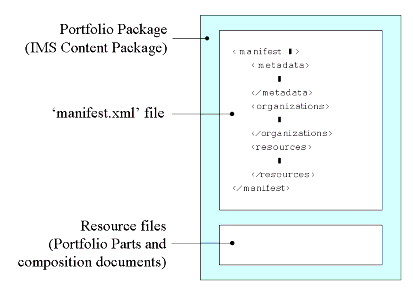
The set of resources contains any source materials that are described as part of the portfolio, e.g., examples of work, copies of certificates, etc.
1EdTech Content Packaging can also be used to exchange more than one Portfolio. Each Portfolio is defined in its own content package i.e. with a single manifest file. Sets of Portfolios are exchanged by creating a top-level content package in which each portfolio package is a resource; see Figure 3.2 for a schematic representation.
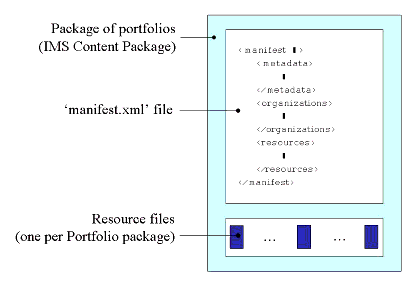
It should be noted that (sub)manifests are not used to exchange multiple portfolios. A (sub)manifest may be used in the construction of a single portfolio (see the 1EdTech ePortfolio Best Practices [EP, 05c] and XML Binding [EP, 05b] documents).
4. Data Model
NOTE: The attributes typed as "LIP" reflect the structures of the 1EdTech Learner Information Package specification [LIP, 01]. For more details please see this specification. The UML diagrams that follow are based on the profiling guidelines of the 1EdTech General Web Services specification [GWS, 05]. The modelling tool Poseidon by Gentleware was used to create the diagrams.
4.1 Portfolio Class
Portfolio is the main class representing an ePortfolio. Portfolio collects the set of information parts described using the PortfolioPart class, and optionally provides a specification for displaying the collection using an instance of the Presentation class.
The relationship between portfolios, owners, views, and presentation as a Content Package is shown in Figure 4.1.
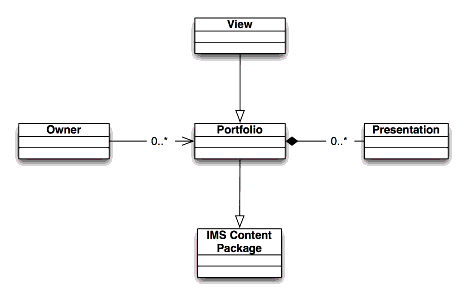
4.1.1 Owner Class (Abstract)
The Owner class represents, abstractly, that a Portfolio has an Owner, and that an Owner may have more than one Portfolio.
It is not intended that any binding will implement Owner as a concrete class. In the ePortfolio XML Binding v1.0, the owner of a Portfolio is represented by an instance of the Identification class.
4.1.2 Presentation Class
The Presentation class represents a specification for the presentation of the Portfolio, including the selection and ordering of items from the set of available PortfolioParts and their constituent attributes.
This class does not have a concrete definition, but should be realized by a filtering and display technology appropriate to the binding in use. In the ePortfolio XML Binding v1.0, a presentation is defined through inclusion of an XSL and/or CSS file within the Portfolio Package.
4.1.3 View Class (Abstract)
The View class represents, abstractly, that a View is a type of Portfolio, differing only in the context of use. A View, in practice, represents a subset of a larger collection of PortfolioParts provided for a specific purpose, but which, in expression, is structurally identical to a Portfolio.
The View class will use the same concrete definition as that of the Portfolio class. In the ePortfolio XML Binding v1.0, a view may be defined through inclusion of an XSL file within the Portfolio Package.
The Portfolio class description is shown in Figure 4.2.
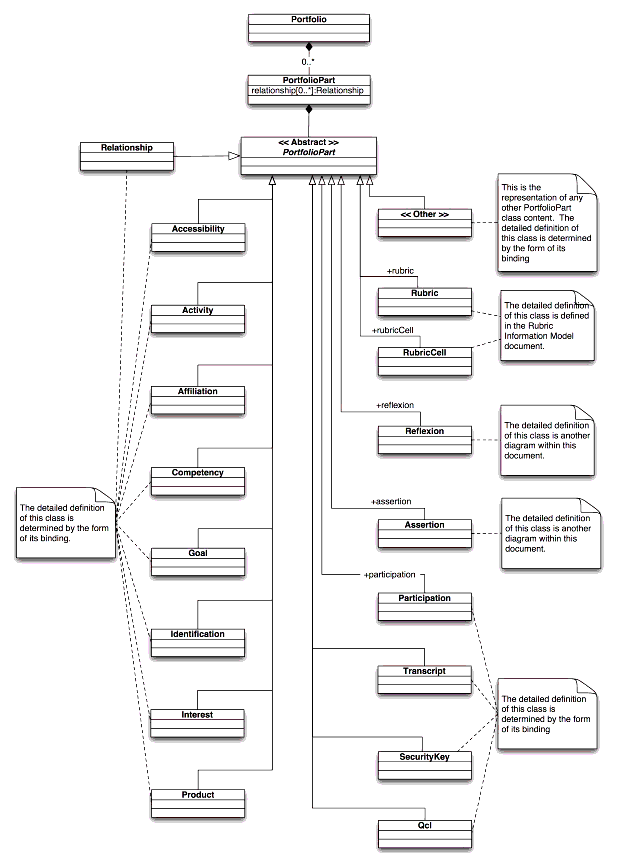
4.2 PortfolioPart Class (Abstract)
The PortfolioPart class is used to represent the superset of the components of a Portfolio. It is not intended that any binding will implement PortfolioPart as a concrete class.
The set of associations for PortfolioPart are summarized as follows:
4.2.1 Accessibility Class
The Accessibility class consists of the technical preferences of the learner for interacting with systems and content. It describes the learner's preferences for particular content characteristics, and for the display of content and control of the interface including the use of assistive technology hardware/software.
This class does not have a concrete definition, but should be realized by a technology appropriate to the binding in use. In the 1EdTech ePortfolio XML Binding, the 1EdTech Accessibility for LIP specification (ACCLIP) is used.
4.2.2 Activity Class
The Activity class consists of the education/training, work, and service (military, community, voluntary, etc.) record and products (excluding formal awards).
This information may include the descriptions of the courses undertaken and the records of the corresponding assessment.
A separate Activity instance will be used for each entry.
This class does not have a concrete definition, but should be realized by a technology appropriate to the binding in use. In the 1EdTech ePortfolio XML Binding, the Activity class from the 1EdTech LIP specification is used.
4.2.3 Affiliation Class
The Affiliation class is used to store the descriptions of the organization affiliations associated with the learner, e.g., professional memberships.
This class does not have a concrete definition, but should be realized by a technology appropriate to the binding in use. In the 1EdTech ePortfolio XML Binding, the Affiliation class from the 1EdTech LIP specification is used.
4.2.4 Assertion Class
The "Assertion" will contain texts, but not reflections, relevant either to the learner or to the other parts of the Portfolio, or to other things signified by the Portfolio.
This class will use the definition provided in sub-section 4.3 of this document.
4.2.5 Competency Class
The Competency class consists of the descriptions of the skills the learner has acquired.
These skills may be associated with some formal or informal training or work history (described by an Activity) and formal awards (described by a Qualification). The corresponding level of competency may also be defined. A different Competency instance will be used for each competency.
This class does not have a concrete definition, but should be realized by a technology appropriate to the binding in use. In the ePortfolio XML Binding, the Competency class from the 1EdTech LIP specification is used.
4.2.6 Goal Class
The Goal class consists of the description of the personal objectives and aspirations of the Owner.
These descriptions may also include information for monitoring the progress in achieving the goals.
A Goal may be defined in terms of sub-goals.
A different Goal instance will be used for each goal.
This class does not have a concrete definition, but should be realized by a technology appropriate to the binding in use. In the ePortfolio XML Binding, the Activity class from the 1EdTech LIP specification is used.
4.2.7 Identification Class
Identification represents the identity of the Owner of the Portfolio, and may include their name, contact information, and demographics.
A Portfolio will contain one, and only one, Identification instance.
This class does not have a concrete definition, but should be realized by a technology appropriate to the binding in use. In the ePortfolio XML Binding, the Identification class from the 1EdTech LIP specification is used.
4.2.8 Interest Class
The Interest class consists of descriptions of the hobbies and other recreational activities of the Owner of the Portfolio. These interests may have formal awards (as described in an associated Qualification). Electronic versions of the products of these interests may also be contained.
A different Interest instance will be used for each interest.
This class does not have a concrete definition, but should be realized by a technology appropriate to the binding in use. In the ePortfolio XML Binding, the Interest class from the 1EdTech LIP specification is used.
4.2.9 Other
This is the representation of any other PortfolioPart class content. The detailed definition of this class is determined by the form of its binding.
4.2.10 Participation Class
The Participation class defines a group of people, which may or may not include the Owner of the Portfolio. The Participation may be used to represent a group of people who collaborated on the creation of a Product, or participated together in an Activity.
This class does not have a concrete definition, but should be realized by a technology appropriate to the binding in use. In the ePortfolio XML Binding, the data model for the 1EdTech Enterprise Services specification [ES, 04] is used.
4.2.11 Product Class
The Product class references materials produced by the Owner. These materials can consist of any material that can be stored or referenced electronically.
This class does not have a concrete definition, but should be realized by a technology appropriate to the binding in use. In the ePortfolio XML Binding, the Product class from the 1EdTech LIP specification is used.
4.2.12 QCL Class (Qualification Class)
The Qualification class consists of the qualifications, certifications, and licenses awarded to the learner, that is, the formally recognized products of their learning and work history.
This includes information on the awarding body and may also include electronic copies of the actual documents.
A different Qualification instance will be used for each qualification, certificate, or license.
This class does not have a concrete definition, but should be realized by a technology appropriate to the binding in use. In the ePortfolio XML Binding, the "qcl" class from the 1EdTech LIP specification is used.
4.2.13 Reflexion Class
The Reflexion class represents reflections upon, or assertions about, a PortfolioPart, such as providing a comment or explanation, identifying strengths and weaknesses, or highlighting particular aspects of the PortfolioPart.
This class will use the definition provided in sub-section 4.4 of this document.
4.2.14 Relationship Class
The Relationship class represents the linking together of two PortfolioPart instances.
This class does not have a concrete definition, but should be realized by a technology appropriate to the binding in use. In the ePortfolio XML Binding [EP, 05b], the Relationship class from the 1EdTech LIP specification is used.
4.2.15 Rubric Class
The Rubric class represents guidance as to how a PortfolioPart has been or is to be assessed. It does not provide for marking/grading schemes in their full glory nor does it provide an information model to support automated marking software.
This class uses the definition in the Rubric Specification [RUBRIC, 05].
4.2.16 RubricCell Class
The RubricCell represents the intersection of dimensions of quality within a Rubric. A RubricCell may be used to refer to outcomes that occur at the intersection of dimensions of quality within a rubric. For definitions of dimensions of quality and outcomes, see the Rubric Specification, section 2 [RUBRIC, 05]. RubricCells facilitate representing relationships between other elements and these intersections.
This class does not have a concrete definition, but should be realized by a technology appropriate to the binding in use.
4.2.17 SecurityKey Class
The SecurityKey class is used to contain the passwords, security codes, etc. to be used when communicating with the learner.
A different SecurityKey instance will be used for each key and class of key.
This class does not have a concrete definition, but should be realized by a technology appropriate to the binding in use.
4.2.18 Transcript Class
The Transcript class is used to store the summary records of the academic performance at an institution. This information may contain an arbitrary level of detail and so there is no prescribed structure for a transcript.
This class does not have a concrete definition, but should be realized by a technology appropriate to the binding in use.
4.3 Assertion Class Description
4.3.1 Description
The "Assertion" will contain texts, but not reflections, relevant either to the learner, or to the other parts of the Portfolio, or to other things signified by the Portfolio.
Note: An "Assertion" can be authored by anyone, including the learner.
Figure 4.3 represents the composition of Assertion diagrammatically as a UML class model.
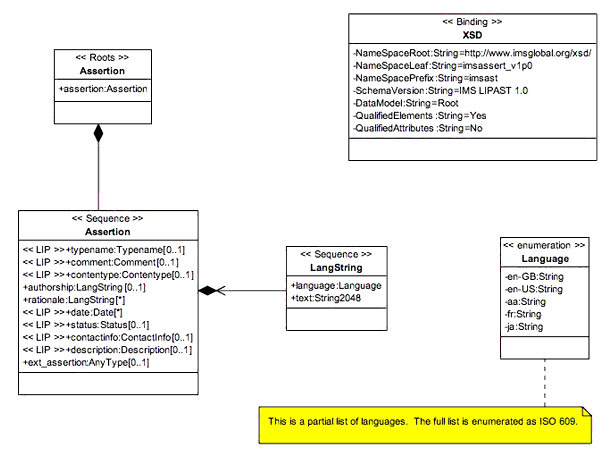
4.3.2 Attributes
The Assertion class attributes are described in Table 4.1. The Types for these attributes are defined in the 1EdTech Learner Information Package v1.0 specification [LIP, 01].
4.4 Reflexion Class Description
4.4.1 Description
The Reflexion class represents reflections upon, or assertions about, a PortfolioPart, such as providing a comment or explanation, identifying strengths and weaknesses, or highlighting particular aspects of the PortfolioPart.
Note: A "Reflexion" can be about anything, whether or not it is represented as another part of the learner information.
Figure 4.4 represents the composition of Reflexion diagrammatically as a UML class model.
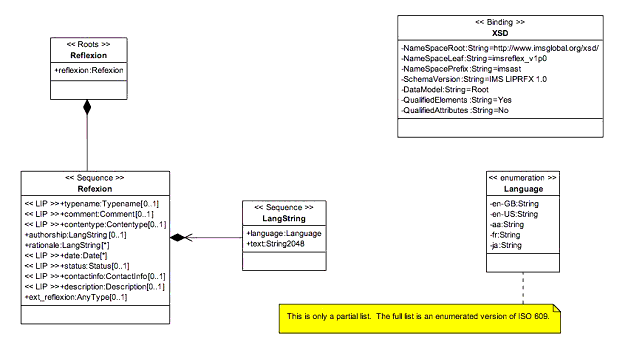
4.4.2 Attributes
The Reflexion class attributes are described in Table 4.2. The Types for these attributes are defined in the 1EdTech Learner Information Package v1.0 specification [LIP, 01].
5. Extending the Information Model
5.1 Proprietary Extensions
The data models defined within this document - Reflexion and Assertion - may be extended using the attributes with the type Extension provided in the class definitions as the point from which to add additional information. The mechanism for doing so will use the approach defined in the 1EdTech Learner Information Package Binding Document [LIP, 01].
PortfolioPart data models may be extended using the mechanisms defined by the binding technology and according to rules defined in the appropriate specifications. For more information, consult the ePortfolio XML Binding [EP, 05b], and the specifications for the referenced bindings for the PortfolioPart to be extended. Additional types of PortfolioPart may also be included in the Portfolio data model in the same manner.
About This Document
| Title | 1EdTech ePortfolio Information Model |
| Editors | Colin Smythe (1EdTech), Darren Cambridge (EDUCAUSE), Mark McKell (1EdTech) |
| Team Co-Leads | Darren Cambridge (EDUCAUSE), Andy Heath (EPICC) |
| Version | 1.0 |
| Version Date | 02 June 2005 |
| Status | Final Specification |
| Summary | This document describes the Information Model of the ePortfolio specification. |
| Revision Information | 02 June 2005 |
| Purpose | This document has been approved by the 1EdTech Technical Board and is made available for adoption. |
| Document Location | http://www.imsglobal.org/ep/epv1p0/imsep_infov1p0.html |
| To register any comments or questions about this specification please visit: http://www.imsglobal.org/developers/ims/imsforum/categories.cfm?catid=24 |
List of Contributors
The following individuals contributed to the development of this document:
Revision History
Index
A
Accessibility 1
B
Behavior 1
Binding 1, 2, 3, 4, 5, 6, 7
C
CSS 1
E
Elements
relationship 1
ePortfolio 1, 2, 3, 4, 5, 6, 7, 8, 9, 10
I
IEEE 1
1EdTech Specifications
Content Packaging 1, 2
Learner Information Package 1, 2, 3, 4, 5, 6, 7, 8
Learner Information Package Accessibility for LIP 1, 2
Reusable Definition of Competency or Education Objective 1
L
Learning 1, 2, 3, 4
Learning Object 1
LOM 1
P
Package 1, 2, 3
Portfolio 1, 2, 3
Preferences 1, 2
R
Records 1, 2
Repositories 1
Rubric 1
S
Services 1, 2
Standards 1, 2
Structure 1, 2, 3
X
XML 1, 2
XSD 1
XSL 1, 2, 3
XSLT 1
1EdTech Consortium, Inc. ("1EdTech/GLC") is publishing the information contained in this 1EdTech ePortfolio Information Model ("Specification") for purposes of scientific, experimental, and scholarly collaboration only.
1EdTech/GLC makes no warranty or representation regarding the accuracy or completeness of the Specification.
This material is provided on an "As Is" and "As Available" basis.
The Specification is at all times subject to change and revision without notice.
It is your sole responsibility to evaluate the usefulness, accuracy, and completeness of the Specification as it relates to you.
1EdTech/GLC would appreciate receiving your comments and suggestions.
Please contact 1EdTech/GLC through our website at http://www.imsglobal.org
Please refer to Document Name: 1EdTech ePortfolio Information Model Revision: 02 June 2005


